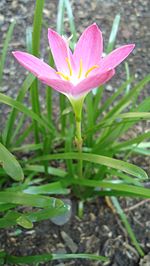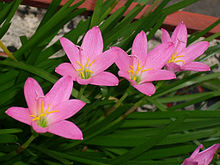- Zephyranthes rosea
-
For other plants with the same common name, see Pink rain lily.
Zephyranthes rosea 
Scientific classification 
Kingdom: Plantae clade: Angiosperms clade: Monocots Order: Asparagales Family: Amaryllidaceae Subfamily: Amaryllidoideae Tribe: Hippeastreae Genus: Zephyranthes Species: Z. rosea Binomial name Zephyranthes rosea
Lindl.Synonyms[1][2] - Amaryllis carnea Schult. & Schult.f.
- Amaryllis rosea (Lindl.) Spreng. nom. illeg.
- Atamasco rosea (Lindl.) Greene
- Zephyranthes carnea (Schult. & Schult.f.) D.Dietr.
Zephyranthes rosea, commonly known as the Cuban zephyr lily or the pink rain lily, is a species of rain lily native to the Caribbean. They are widely cultivated as ornamentals and have become naturalized in tropical regions worldwide. Like all rain lilies, they are known for blooming only after heavy rains.
They contain potentially lethal toxins.
Contents
Description
 A pink Zephyranthes rosea from Kooveri, Kerala
A pink Zephyranthes rosea from Kooveri, Kerala
Z. rosea are perennial herbaceous monocots. They are small plants, reaching only 15 to 20 cm (5.9 to 7.9 in) in height.[3] They bear five to six narrow and flattened dark green linear leaves, about 3 to 4 mm (0.12 to 0.16 in) wide, from spherical tunicate bulbs around 1.5 to 2.5 centimetres (0.59 to 0.98 in) in diameter.[4][5][6]
The single funnel-shaped flowers are borne erect or slightly inclined on scapes around 10 to 15 cm (3.9 to 5.9 in) long. The spathes are around 2 to 2.8 cm (0.79 to 1.1 in) long and slightly divided only at the tip.[7] The fragrant six-petaled flowers are around 2.5 cm (0.98 in) in diameter and 3 to 3.5 cm (1.2 to 1.4 in) in length. The perianth is bright pink with a green central perianth tube that is less than 5 mm (0.20 in) long.[5][8][9] The six stamens are of different lengths – one of 11 mm (0.43 in), one of 16 mm (0.63 in), and four between 12 to 13 mm (0.47 to 0.51 in).[5] They are shorter than the style and inserted at the mouth of the perianth.[7] The anthers are 3 to 6 mm (0.12 to 0.24 in) long.[10]
The flowers develop into capsules that are divided deeply into three lobes.[11] The seeds are shiny black and flattened.[4]
Classification
Zephyranthes rosea belongs to the genus Zephyranthes (rain lilies) of the subtribe Zephyranthinea of the tribe Hippeastreae.[12] It is classified under the subfamily Amaryllidoideae of the Amaryllis family (Amaryllidaceae). In broader classifications, they are sometimes included within the lily family (Liliaceae).[13]
Nomenclature
Z. rosea (like other rain lilies) are so named because they produce short-lived flowers only after seasonal heavy rains or storms.[5][14][15] In Z. rosea, this usually occurs during the late summer.[16][17] The generic name Zephyranthes literally means "flowers of the west wind", from Greek ζέφυρος (zéphuros, an Anemoi) and ἄνθος (anthos, 'flower').[18] Zephyrus, the Greek personification of the west wind, is also associated with rainfall.[16] The specific name comes from Latin for 'rosy'.
Other common names of Z. rosea include 'pink rain lily', 'pink fairy lily', 'pink magic lily', 'pink zephyr lily', 'rain flower', and 'rose rain lily'.[19][20][21] It is also commonly known as duende rojo ('red dwarf') and leli de San Jose in Spanish;[4] and rosafarbene and Windblume in German.[13]
Z. rosea is one of the two Zephyranthes species known as the 'pink rain lily'. The other species is Zephyranthes carinata, usually referred to incorrectly as Zephyranthes grandiflora. Z. carinata is often mislabeled as Z. rosea by merchants.[16][22] Z. carinata can be distinguished from true Z. rosea by their much larger flowers with a deeper pink coloration.[23][24][25] Z. rosea also has 24 chromosomes in diploid somatic cells, in contrast to 48 in Z. carinata.[26]
Another similar species known under the same common names is Habranthus robustus. They can be differentiated from Z. rosea by having paler pink and larger flowers.
Distribution and habitat
Z. rosea is native to the Caribbean, particularly Cuba, Puerto Rico, Guadeloupe, and Martinique.[13] It has been introduced and naturalized to tropical North America, Central America, South America, Asia, Australia, and some Pacific Islands.[27] They are common in recently disturbed land and grassy areas (like lawns and meadows) that receive periodical rainfall.[8][9]
Uses
Z. rosea are usually propagated by dividing clumps of bulbs, but can also be grown from seeds. They are widely cultivated as ornamental plants.[7] They are relatively low-maintenance, becoming dormant during extended periods of drought. They are less tolerant of colder temperatures than other species of Zephyranthes, however.[16]
In India, they are also used in folk medicine, along with Zephyranthes flava.[28]
Toxicity
The bulbs of Z. rosea, like other members of Zephyranthes and Habranthus, contain various toxic alkaloids including lycorine and haemanthamine.[29] They can cause vomiting, convulsions, and death to humans, livestock, and poultry.[16]
Pests and diseases
Pests of Z. rosea include chewing insects. They are also vulnerable to the necrotrophic fungus Botrytis cinerea.[17]
See also
- Zephyranthes atamasco – the Atamasco lily
- Zephyranthes candida – the white rain lily
- Zephyranthes puertoricensis – the Puerto Rican zephyr lily
- Habranthus – a closely related genus
References
- ^ "Zephyranthes rosea Lindl.". Tropicos.org, Missouri Botanical Garden. http://www.tropicos.org/Name/1200426?projectid=4. Retrieved August 7, 2011.
- ^ "Zephyranthes rosea Lindl.". The Plant List. http://www.theplantlist.org/tpl/record/kew-292012. Retrieved August 7, 2011.
- ^ Kirti Mathura (2007). The Arizona Low Desert Flower Garden: A Seasonal Guide to Bloom, Height, Color, and Texture. Gibbs Smith. p. 134. ISBN 9781586858964. http://books.google.com.ph/books?id=hBYadBBbvaoC&lpg=PP1&hl=en&pg=PA134#v=onepage&q&f=false.
- ^ a b c Pedro Acevedo-Rodríguez & Mark T. Strong (2005). "Monocotyledons and Gymnosperms of Puerto Rico and the Virgin Islands". Contributions from the United States National Herbarium (Smithsonian Institution) 52: 1–415. http://botany.si.edu/Antilles/PRFlora/monocots/vol52web.pdf. Retrieved August 7, 2011.
- ^ a b c d José Luis Fernández-Alonso & Jeroen P. Groenendijk (2004). "A New Species of Zephyranthes Herb. S. L. (Amaryllidaceae, Hippeastreae), with Notes on the Genus in Colombia". Rev. Acad. Colomb. Cienc. 28 (107): 177–186. ISSN 0370-3908. http://www.accefyn.org.co/revista/Vol_28/107/177-186.pdf. Retrieved August 7, 2011.
- ^ "Zephyranthes rosea Lindl.". Hortus Camdensis. http://hortuscamden.com/plants/view/zephyranthes-rosea-lindl. Retrieved August 7, 2011.
- ^ a b c Stuart Max Walters (1986). The European Garden Flora: Pteridophyta, Gymnospermae, Angiospermae. Cambridge University Press. p. 294. ISBN 9780521248594. http://books.google.com.ph/books?id=1dd5M-ToXAcC&lpg=PP1&hl=en&pg=PA294#v=onepage&q&f=false.
- ^ a b Rita Buchanan & Roger Holmes (2001). Taylor's Master Guide to Gardening. Houghton Mifflin Harcourt. p. 521. ISBN 9780618159079. http://books.google.com.ph/books?id=sWrSM-4CoLoC&lpg=PP1&hl=en&pg=PA521#v=onepage&q&f=false.
- ^ a b David W. Nellis (1997). Poisonous plants and animals of Florida and the Caribbean. Pineapple Press Inc.. p. 7. ISBN 9781561641116. http://books.google.com.ph/books?id=C8xJE2NfQpIC&lpg=PP1&hl=en&pg=PA7#v=onepage&q&f=false.
- ^ "Zephyranthes rosea Lindley, Bot. Reg. 10: plate 821. 1824.". Flora of North America, eFloras.org. http://www.efloras.org/florataxon.aspx?flora_id=1&taxon_id=242102088. Retrieved August 7, 2011.
- ^ "Zephyranthes rosea (Spreng.) Lindl., Bot. Reg. 10: t. 821 (1824)". Flora of Australia Online, Australian Biological Resources Study. http://www.anbg.gov.au/abrs/online-resources/flora/stddisplay.xsql?pnid=55586. Retrieved August 7, 2011.
- ^ Pascal Vigneron. "Hippeastreae". Amaryllidaceae.org. http://www.amaryllidaceae.org/Hippeastreae.htm. Retrieved August 9, 2011.
- ^ a b c "Zephyranthes rosea Lindl.". Germplasm Resources Information Network (GRIN) online database. http://www.ars-grin.gov/cgi-bin/npgs/html/taxon.pl?42238. Retrieved August 7, 2011.
- ^ "Zephyranthes rosea". College of Micronesia – FSM. http://www.comfsm.fm/~dleeling/angio/zephyranthes_rosea.html. Retrieved August 7, 2011.
- ^ "The Rain Lily". Types of Lilies. http://typesoflilies.com/rain_lily/rain_lily.html. Retrieved August 7, 2011.
- ^ a b c d e Gary W. Knox (2005). "Rainlily, Zephyranthes and Habranthus spp.: Low Maintenance Flowering Bulbs for Florida Gardens". ENH1151 (Institute of Food and Agricultural Sciences Extension, University of Florida). http://edis.ifas.ufl.edu/pdffiles/EP/EP41200.pdf. Retrieved August 7, 2011.
- ^ a b Edward F. Gilman (1999). "Rainlily, Zephyranthes spp". Fact Sheet FPS-621 (IFAS Extension, University of Florida). http://hort.ufl.edu/database/documents/pdf/shrub_fact_sheets/zepsppa.pdf. Retrieved August 7, 2011.
- ^ Bobby J. Ward. "Flowers of the West Wind: Rain Lilies". www.bobbyjward.com. http://www.bobbyjward.com/articles/mexican_transplant.htm. Retrieved August 7, 2011.
- ^ "Zephyranthes rosea Lindl. – Cuban zephyrlily". USDA-NRCS PLANTS Database. http://plants.usda.gov/java/nameSearch?mode=Scientific+Name&go.x=8&go.y=10&go=go&keywordquery=Zephyranthes+rosea. Retrieved August 7, 2011.
- ^ "Zephyranthes rosea". Atlas of Florida Vascular Plants, Institute for Systematic Botany. http://florida.plantatlas.usf.edu/Plant.aspx?id=107. Retrieved August 7, 2011.
- ^ "Rose Rain Lily". Cook Islands Biodiversity & Natural Heritage. http://cookislands.bishopmuseum.org/species.asp?id=6800. Retrieved August 7, 2011.
- ^ "Zephyranthes grandiflora". Gay Gardener. http://www.gaygardener.com/gardenspot/bulbs022.phtml. Retrieved August 7, 2011.
- ^ William Lanier Hunt (1992). Southern Gardens, Southern Gardening. Duke University Press. p. 57. ISBN 9780822312239. http://books.google.com.ph/books?id=P1evhT9H0qcC&lpg=PP1&hl=en&pg=PA57#v=onepage&q&f=false.
- ^ "Zephyranthes grandiflora Lindl.". Zanthan Plant Profile. http://www.zanthan.com/gardens/plants/zephyranthes1.html. Retrieved August 7, 2011.
- ^ "Zephyranthes grandiflora Lindl.". Hortus Camdenensis. http://hortuscamden.com/plants/view/zephyranthes-grandiflora-lindl. Retrieved August 7, 2011.
- ^ Puangpaga Soontornchainaksang & Kanyarat Chaiyasut (1996). "Cytogenetic study of Some Thai Species of Flowering Plants". Thai For. Bull. (Bot.) 24: 50–61. http://web3.dnp.go.th/botany/PDF/TFB/TFB24/TFB24_3Cytogenetic.pdf. Retrieved August 7, 2011.
- ^ "Zephyranthes rosea Lindl.". Discover Life. http://www.discoverlife.org/mp/20q?search=Zephyranthes+rosea. Retrieved August 7, 2011.
- ^ Lucie Cahlíková, Irena Valterová, Kateřina Macáková, & Lubomír Opletal (2010). "Analysis of Amaryllidaceae alkaloids from Zephyranthes grandiflora by GC/MS and their cholinesterase activity". Brazilian Journal of Pharmacognosy (Revista Brasileira de Farmacognosia) (Sociedade Brasileira de Farmacognosia) 5 (8): 1201–1204. ISSN 0102-695X. http://www.scielo.br/pdf/rbfar/2011nahead/aop8711.pdf. Retrieved August 7, 2011.
- ^ Julia F. Morton (1962). "Ornamental Plants With Toxic And/Or Irritant Properties. II.". Proceedings of the Florida State Horticultural Society (Florida State Horticultural Society) 75: 484–491. http://www.fshs.org/Proceedings/Password%20Protected/1962%20Vol.%2075/484-491%20(MORTON).pdf. Retrieved August 7, 2011.
Categories:- Poisonous plants
- Amaryllidoideae
Wikimedia Foundation. 2010.


